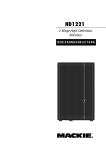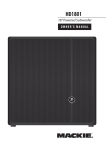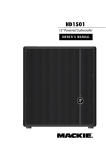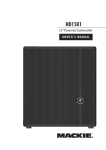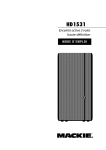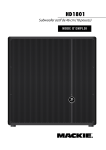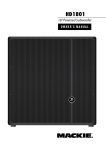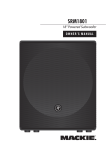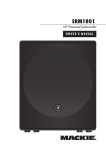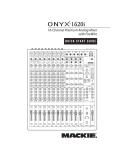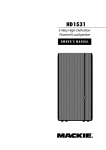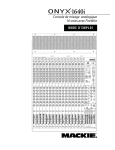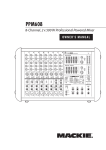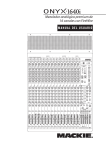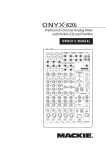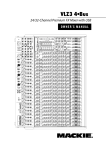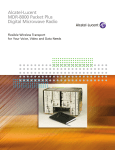Download Mackie 2-Way User's Manual
Transcript
HD1221 2-Way High-Definition Powered Loudspeaker OWNER’S MANUAL HD1221 Important Safety Instructions 1. 2. 3. 4. 5. 6. 7. Read these instructions. Keep these instructions. Heed all warnings. Follow all instructions. Do not use this apparatus near water. Clean only with a dry cloth. Do not block any ventilation openings. Install in accordance with the manufacturer’s instructions. 8. Do not install near any heat sources such as radiators, heat registers, stoves, or other apparatus (including amplifiers) that produce heat. 9. Do not defeat the safety purpose of the polarized or grounding-type plug. A polarized plug has two blades with one wider than the other. A grounding-type plug has two blades and a third grounding prong. The wide blade or the third prong are provided for your safety. If the provided plug does not fit into your outlet, consult an electrician for replacement of the obsolete outlet. 10. Do not overload wall outlets and extension cords as this can result in a risk of fire or electric shock. 11. Protect the power cord from being walked on or pinched particularly at plugs, convenience receptacles, and the point where they exit from the apparatus. 12. Only use attachments/accessories specified by the manufacturer. PORTABLE CART 13. Use only with a cart, stand, tripod, bracket, or WARNING table specified by the manufacturer, or sold with the apparatus. When a cart is used, use caution when moving the cart/apparatus combination to avoid injury from tip-over. 14. Unplug this apparatus during lightning storms or when unused for long periods of time. 15. Refer all servicing to qualified service personnel. Servicing is required when the apparatus has been damaged in any way, such as powersupply cord or plug is damaged, liquid has been spilled or objects have fallen into the apparatus, the apparatus has been exposed to rain or moisture, does not operate normally, or has been dropped. 16. This apparatus shall not be exposed to dripping or splashing, and no object filled with liquids, such as vases or beer glasses, shall be placed on the apparatus. 17. This apparatus has been designed with Class-I construction and must be connected to a mains socket outlet with a protective earthing connection (the third grounding prong). 18. The MAINS plug or an appliance coupler is used as the disconnect device, so the disconnect device shall remain readily operable. CAUTION AVIS RISK OF ELECTRIC SHOCK. DO NOT OPEN RISQUE DE CHOC ELECTRIQUE. NE PAS OUVRIR CAUTION: TO REDUCE THE RISK OF ELECTRIC SHOCK DO NOT REMOVE COVER (OR BACK) NO USER-SERVICEABLE PARTS INSIDE. REFER SERVICING TO QUALIFIED PERSONNEL ATTENTION: POUR EVITER LES RISQUES DE CHOC ELECTRIQUE, NE PAS ENLEVER LE COUVERCLE. AUCUN ENTRETIEN DE PIECES INTERIEURES PAR L'USAGER. CONFIER L'ENTRETIEN AU PERSONNEL QUALIFIE. AVIS: POUR EVITER LES RISQUES D'INCENDIE OU D'ELECTROCUTION, N'EXPOSEZ PAS CET ARTICLE A LA PLUIE OU A L'HUMIDITE The lightning flash with arrowhead symbol within an equilateral triangle is intended to alert the user to the presence of uninsulated "dangerous voltage" within the product's enclosure, that may be of sufficient magnitude to constitute a risk of electric shock to persons. Le symbole éclair avec point de flèche à l'intérieur d'un triangle équilatéral est utilisé pour alerter l'utilisateur de la présence à l'intérieur du coffret de "voltage dangereux" non isolé d'ampleur suffisante pour constituer un risque d'éléctrocution. The exclamation point within an equilateral triangle is intended to alert the user of the presence of important operating and maintenance (servicing) instructions in the literature accompanying the appliance. Le point d'exclamation à l'intérieur d'un triangle équilatéral est employé pour alerter les utilisateurs de la présence d'instructions importantes pour le fonctionnement et l'entretien (service) dans le livret d'instruction accompagnant l'appareil. 2 HD1221 19.NOTE: This equipment has been tested and found to comply with the limits for a Class B digital device, pursuant to part 15 of the FCC Rules. These limits are designed to provide reasonable protection against harmful interference in a residential installation. This equipment generates, uses, and can radiate radio frequency energy and, if not installed and used in accordance with the instructions, may cause harmful interference to radio communications. However, there is no guarantee that interference will not occur in a particular installation. If this equipment does cause harmful interference to radio or television reception, which can be determined by turning the equipment off and on, the user is encouraged to try to correct the interference by one or more of the following measures: • Reorient or relocate the receiving antenna. • Increase the separation between the equipment and the receiver. • Connect the equipment into an outlet on a circuit different from that to which the receiver is connected. • Consult the dealer or an experienced radio/TV technician for help. CAUTION: Changes or modifications to this device not expressly approved by LOUD Technologies Inc. could void the user's authority to operate the equipment under FCC rules. 20. This apparatus does not exceed the Class A/Class B (whichever is applicable) limits for radio noise emissions from digital apparatus as set out in the radio interference regulations of the Canadian Department of Communications. ATTENTION — Le présent appareil numérique n’émet pas de bruits radioélectriques dépassant las limites applicables aux appareils numériques de class A/de class B (selon le cas) prescrites dans le réglement sur le brouillage radioélectrique édicté par les ministere des communications du Canada. 21. Exposure to extremely high noise levels may cause permanent hearing loss. Individuals vary considerably in susceptibility to noise-induced hearing loss, but nearly everyone will lose some hearing if exposed to sufficiently intense noise for a period of time. The U.S. Government’s Occupational Safety and Health Administration (OSHA) has specified the permissible noise level exposures shown in the following chart. According to OSHA, any exposure in excess of these permissible limits could result in some hearing loss. To ensure against potentially dangerous exposure to high sound pressure levels, it is recommended that all persons exposed to equipment capable of producing high sound pressure levels use hearing protectors while the equipment is in operation. Ear plugs or protectors in the ear canals or over the ears must be worn when operating the equipment in order to prevent permanent hearing loss if exposure is in excess of the limits set forth here: Duration, per day in hours 8 6 4 3 2 1.5 1 Sound Level dBA, Slow Response 90 92 95 97 100 102 105 0.5 110 0.25 or less 115 Typical Example Duo in small club Subway Train Very loud classical music Poonswang screaming at desTROYer about deadlines Loudest parts at a rock concert WARNING — To reduce the risk of fire or electric shock, do not expose this apparatus to rain or moisture. DANGER: Loudspeakers should be mounted or suspended only by persons with knowledge of the proper hardware and rigging techniques. When stacking or pole-mounting loudspeakers, be sure that they are stabilized and secured from falling over or being accidentally pushed over. Failure to follow these precautions may result in damage to the equipment, personal injury, or death. Contents IMPORTANT SAFETY INSTRUCTIONS INTRODUCTION FEATURES HOOKUP DIAGRAMS REAR PANEL FEATURES PLACEMENT ROOM ACOUSTICS RIGGING THERMAL CONSIDERATIONS AC POWER CARE AND MAINTENANCE APPENDIX A: SERVICE INFORMATION APPENDIX B: CONNECTIONS APPENDIX C: TECHNICAL INFORMATION HD1221 BLOCK DIAGRAM HD1221 GRAPHS AND DIMENSIONS HD1221 LIMITED WARRANTY 2 3 3 4 7 9 10 11 13 13 13 14 15 16 17 18 19 Introduction Features The HD1221 Powered Loudspeaker represents a major step into portable high-definition live sound, providing precise, articulate full-range sound at the high-output levels demanded of modern PA systems. Two Class-D Fast Recovery™ amplifiers efficiently drive 1200 Watts of total system power, providing maximum output with minimal distortion. True high-definition sound is possible thanks to an arsenal of technological innovations including patented acoustic correction processing that was previously only available on highend stadium touring systems. This complex processing, along with a phase-coherent electronic crossover and transducer time-alignment provide unparalleled acoustic accuracy that has to be heard to be believed. • 1200W of ultra-efficient Class-D Fast Recovery™ amplification • LF 500W RMS / 1000W peak • HF 100W RMS / 200W peak • High-definition digital processing includes: • Revolutionary patented acoustic correction • Transducer time alignment and phase correction • Precision 2-way crossover • Custom designed transducers by EAW • 12” neodymium woofer with 3” voice coil • 1.75” compression driver with heat-treated titanium diaphragm • Custom designed user-rotatable 90˚ x 50˚ horn by Martin Audio • 60˚ monitor angle for maximum coverage on stage • Three user-selectable voicing modes for easy system tuning • Ultra-compact and lightweight (50 lb / 22.7 kg) • Integrated limiting and protection circuitry • Rugged all wood cabinet (15mm birch) • 12 integrated fly points for horizontal and vertical rigging • Stand / pole mountable The HD1221 features system tuning, a 12” neodymium woofer and a 1.75” heat-treated titanium compression driver, custom designed by the award winning engineering team at EAW, delivering the ultimate in both quality and performance. A custom rotatable horn by Martin Audio, three selectable voicing modes and extensive protection circuitry complete this ultra-portable, powerful HD system that may be used as the house PA or as monitors for the band. All of these high-end components are housed in a rugged, all-wood enclosure that not only protects, but allows for multiple mounting options including flying and pole mounting. The HD1221 brings high-definition sound to the world of portable PA systems. Part No. SW0845 Rev. A 09/10 ©2010 LOUD Technologies Inc. All Rights Reserved. Owner’s Manual Owner’s Manual 22. Rigging Precautions: When mounting or suspending loudspeaker enclosures, it is essential that load ratings, rigging techniques, and special safety considerations be appropriate for the installation. Use only the mounting/rigging points on the loudspeaker enclosure intended for this purpose. The user must determine the load requirements, dynamic loading, and any other contributing factors affecting the loudspeaker installation. The user must determine the proper design factor for specific applications and the required load rating of the connection to structure. Comply with all applicable federal, state, and local regulations. We strongly recommend the following rigging system practices: • Documentation: Thoroughly document the mounting/rigging design with detailed drawings and parts lists. • Analysis: Have a licensed structural engineer or other qualified professional review and approve the mounting/rigging design before its implementation. • Installation: Use personnel experienced and qualified for mounting/rigging loudspeakers in accordance with and in compliance with all federal, state and local regulations. 3 HD1221 Hookup Diagrams To Mackie HD1221 powered loudspeaker MAIN INPUT To Mackie HD1221 powered loudspeaker MAIN INPUT Power Cord Power Cord L/R MAIN OUT 1 2 3 4 5 6 7 8 9-10 11-12 1 2 3 4 Mixing Console (Mackie CFX12mkII shown) This simple system may be utilized in a variety of ways anywhere high-output and easy setup are needed. Great for wedding DJs to vocal reinforcement to full band PA, the HD1221 is the perfect setup when you need a highoutput, ultra-portable PA. In this example, the left and right main outputs from a mixer feed the MAIN INPUTs of a pair of Mackie HD1221 powered loudspeakers. Note: HD1221s do not necessarily need to be pole-mounted. They may be placed on a floor, stage, or other firm surface or they may be flown for permanent installs. Please refer to pages 9-12 for more information on HD1221 placement, acoustics and rigging. HD1221: 2-WAY SYSTEM 4 HD1221 Mackie HD1221 powered loudspeaker reproduces all frequencies above the subwoofer’s crossover point To Mackie HD1221 powered loudspeaker MAIN INPUT Line level HIGH PASS OUTPUT A Pole Mount Owner’s Manual Mackie HD1221 powered loudspeaker reproduces all frequencies above the subwoofer’s crossover point To Mackie HD1221 powered loudspeaker MAIN INPUT Power Cord Line level HIGH PASS OUTPUT A To Mackie HD1501 powered subwoofer INPUT A Mackie HD1501 powered subwoofer plays the low frequencies Power Cords Pole Mount Power Cord To Mackie HD1501 powered subwoofer INPUT A L/R MAIN OUT Mackie HD1501 powered subwoofer plays the low frequencies Power Cords Mixing Console (Mackie Onyx 1640i shown) Similar to the previous hookup diagram, this one adds some low end to your portable PA. It is perfect for the same setups as mentioned previously [sound reinforcement, weddings, vocal reinforcement, portable PA for a full band of all genres, etc.], as well as for DJs and other functions that call for additional low-end thump. This is the perfect setup when you need an ultra-portable PA with A LOT of output! In this example, the left and right main outputs from a mixer feed the inputs of a pair of Mackie HD1501 powered subwoofers. HIGH PASS OUTPUT A of each subwoofer feed the MAIN INPUTs of the Mackie HD1221 powered loudspeakers. The HD1221s reproduce the mid-to-high frequencies in stereo, and the subs provide the low frequencies in stereo. If just a little extra low end is needed, a single HD1801 may be used with a pair of HD1221s and still retain a stereo image. HD1221: 3-WAY SYSTEM WITH POWERED SUBWOOFERS Owner’s Manual 5 HD1221 Mackie HD1221 powered loudspeakers strewn across the stage in monitor position Power Cord Mackie HD1221 powered loudspeaker LOOP OUT to Mackie HD1221 powered loudspeaker MAIN INPUT for the prima donna lead singer who needs two monitors Power Cord Power Cord LEFT/RIGHT MAIN OUTS to house PA (Mackie HD1801 Power Subwoofers and Mackie HD1531 Powered Loudspeakers not shown, but that would be a great setup!) Power Cord AUX SENDS 1-3 to Mackie HD1221 powered loudspeaker MAIN INPUTS GAIN 1 GAIN 2 GAIN 3 GAIN 4 GAIN 5 GAIN 6 GAIN 7 GAIN 8 GAIN 9 GAIN 10 GAIN 11 GAIN 12 GAIN 13 GAIN 14 GAIN 15 GAIN 16 GAIN 17 GAIN 18 GAIN 19 GAIN 20 GAIN 21/22 GAIN 23/24 2404 AUX MASTERS AUX AUX AUX AUX AUX AUX AUX AUX AUX AUX AUX AUX AUX AUX AUX AUX AUX AUX AUX AUX AUX AUX EQ EQ EQ EQ EQ EQ EQ EQ EQ EQ EQ EQ EQ EQ EQ EQ EQ EQ EQ EQ EQ EQ PAN PAN PAN PAN PAN PAN PAN PAN PAN PAN PAN BAL BAL 1 2 FX 1 PAN 1 PAN 2 PAN 3 PAN 4 PAN 5 PAN 6 PAN 7 PAN 8 PAN 9 10 11 12 13 14 15 16 17 18 19 20 21/22 MAIN MIX STEREO RETURNS FX 2 23/24 1 2 3 4 MAIN MIX Mixing Console (Mackie 2404-VLZ3 shown) This is the perfect setup for using HD1221s as high output, professional stage monitors. This type of setup may be utilized at local clubs, festival stages, in churches and more. In this example, AUX SENDS 1-3 from a mixer feed the MAIN INPUTS of three Mackie HD1221 powered loudspeakers which lay across the front of the stage as monitors for the band. Additionally, a fourth Mackie HD1221 powered loudspeaker is daisy-chained by using the LOOP OUT XLR jack from one of the other monitors, providing two monitors off of a single aux send. See page 15 [‘Appendix B: Connections’] for details on how to daisy-chain loudspeakers. The left and right main outputs from the same mixer feed the MAIN INPUTs of the house PA speakers. See the hook-up diagram on the previous page [‘HD1221: 3-way system with powered subwoofers’] to see how to connect the mixer to the PA. HD1221: MONITOR SETUP 6 HD1221 1. MAIN INPUT This is a female XLR-type connector that accepts a balanced line-level signal from a mixing console or other signal source. See Appendix B for more information about this connector. 2. LOOP OUT HD1221 PARALLEL 1 MAIN INPUT 2 LOOP OUT THERMAL 2-WAY HIGH DEFINITION POWERED LOUDSPEAKER 3 VOICING MODE CONTOUR 4 SIG/ LIMIT POWER LIGHT ON NORMAL MONITOR This is a male XLR-type connector that produces exactly the same signal that is connected to the main input jack. Use it to daisy-chain several HD1221's together off the same signal source. See Appendix B for more information about this connector. - 6dB 5 6 7 +6dB LEVEL Owner’s Manual Rear Panel Features 3. VOICING MODE This built-in 3-position voicing mode switch allows the HD1221 to be tailored for any sound application. CONTOUR Set the Voicing Mode switch to the ‘CONTOUR’ position for low-level applications. This is the perfect setting when a little more low and high end is necessary. The LED next to the switch will illuminate yellow when ‘CONTOUR’ is the chosen voicing mode. NORMAL This is the standard position of the switch, hence the name, ‘NORMAL’. It is ideal for most PA applications where the HD1221 will be cranked. Additionally, this is the recommended position when paired with a subwoofer. Of the three options, this is the most accurate voicing mode and should be used in the majority of applications. The LED next to the switch will illuminate green when ‘NORMAL’ is the chosen voicing mode. MONITOR The ‘MONITOR’ position is designed for when the HD1221 will be used as a stage monitor, but it may also be utilized when you need the vocals to cut through a high-gain, high-output instrument (such as guitar). In this position, the low frequency is rolled off, while the mids and highs are tuned to cut through stage volume with as much gain before feedback as possible. The LED next to the switch will illuminate red when ‘MONITOR’ is the chosen voicing mode. POWER WARNING: TO REDUCE THE RISK OF FIRE OR ELECTRIC SHOCK, DO NOT EXPOSE THIS EQUIPMENT TO RAIN OR MOISTURE. DO NOT REMOVE COVER. NO USER SERVICEABLE AVIS: RISQUE DE CHOC ELECTRIQUE — NE PAS OUVRIR PARTS INSIDE. REFER SERVICING TO QUALIFIED PERSONNEL. SERIAL NUMBER 8 ON REVISION 9 Owner’s Manual 7 HD1221 4. POWER LIGHT ON 7. LEVEL Press this switch in to turn on the front panel power LED if a visual indicator is preferred. The LED next to the switch will light as a reminder. This controls the overall signal level at the input to the built-in power amplifiers. It ranges from –6 dB to +6 dB of gain. The center detent is 0 dB (unity gain). Use this control to vary the level of the HD1221 versus other loudspeakers and subwoofers in your system. Be sure to keep an eye on the SIG/LIMIT LED [6]. If this switch is disengaged [out], and the HD1221 is powered on, the LED on the front of the cabinet will not light, nor will the LED next to the switch. The LED next to the POWER Switch [8] and other rear panel LEDs will still illuminate when the unit is powered on. 5. THERMAL LED The HD1221 is equipped with a thermal protection circuit that monitors the internal temperature of the amplifiers and heatsink. If the temperature exceeds a safe operating level, this indicator lights and the input signal is muted to allow the amplifiers to cool. When the temperature cools to a safe level once again, the thermal protection circuit deactivates, the THERMAL LED turns off and the HD1221 returns to normal operation. When the HD1221 is in thermal protect mode, the unit is still powered on despite the lack of output. If POWER LIGHT ON [4] is engaged, the front panel power LED will go out when in thermal protect mode. Activation of the thermal protection circuit is an indication that you should take steps to avoid continued thermal problems. See ‘Thermal Considerations’ on page 13 for more information. 6. SIG/LIMIT LED This bi-color LED illuminates green whenever there is a signal present at the MAIN INPUT connector. It senses the signal just after the LEVEL control, so adjustments to the LEVEL control will affect the SIG/LIMIT indicator. The HD1221 has a built-in limiter that helps to prevent the amplifier outputs from clipping or overdriving the transducers. The SIG/LIMIT indicator lights yellow when the limiter is activated. It's okay for it to blink yellow occasionally, but if it blinks frequently or lights continuously, turn down the level control until it only blinks occasionally. Excessive limiting may lead to overheating, which in turn trips the thermal protect circuitry and interrupts the performance. See ‘Thermal Considerations’ on page 13 for more information. 8 HD1221 8. POWER Use this switch to turn the HD1221 on and off. The LED next to the switch will illuminate when powered on. The front panel LED will also turn on, but only if the POWER LIGHT ON switch [4] is engaged. Press the bottom of this switch to put the speaker into standby mode. The HD1221 will not function, but the circuits are still live. To remove AC power, either turn off the AC mains supply, or unplug the power cord from the speaker and the AC mains supply. As a general guide, the powered speakers should be turned on last, after the mixer and other sources. They should also be the first things turned off. This will reduce the possibility of any turn-on, or turn-off thumps in your speakers. 9. IEC AC Receptacle This jack accepts the supplied 3-prong AC power cord. Before you plug the AC power cord into the powered loudspeaker, make sure that the voltage of your unit (listed above the IEC AC receptacle) is the same voltage as your local AC mains supply. Use only the power cord supplied. Also, disconnecting the plug’s ground pin is dangerous. Don’t do it. WARNING: Installation should only be done by an experienced technician. Improper installation may result in damage to the equipment, injury or death. Make sure that the loudspeaker is installed in a stable and secure way in order to avoid any conditions that may be dangerous for persons or structures. The HD1221 speaker is designed to sit on the floor or stage as the main PA or as monitors. It may also be polemounted via the built-in socket on the bottom of the cabinet. Be sure the pole is capable of supporting the weight of the HD1221. The Mackie SPM200 is a great option when using a sub. The HD1221 may also be flown horizontally or vertically via its 12 integrated fly points as detailed on page 11. Check to make sure that the support surface (e.g., floor, etc.) has the necessary mechanical characteristics to support the weight of the loudspeaker(s). When pole-mounting loudspeakers, be sure that they are stabilized and secured from falling over or being accidentally pushed over. Failure to follow these precautions may result in damage to the equipment, personal injury, or death. As with any powered components, protect them from moisture. Avoid installing the loudspeaker in places exposed to harsh weather conditions. If you are setting them up outdoors, make sure they are under cover if you expect rain. You can create a horizontal array by placing the cabinets side-by-side. However, you should have a good understanding of the relationship between the splay angle (the angle between the facing sides of the cabinets) and frequency cancellation effects between cabinets. When two cabinets are positioned side-by-side such that the rear-angled faces of the enclosures are parallel, the splay angle will be 90º. This matches the 90˚ horizontal coverage pattern of each individual HD1221; the interference between the two cabinets will be minimized, but the total coverage of 180˚ may be too wide for some applications (see Figure A). The mid and high frequencies may also be reduced for those in the center who are too close to the loudspeakers. Owner’s Manual Placement Reducing the splay angle will reduce the total horizontal coverage, but it also creates an area both speakers are covering. Instead of a nearfield hole, this will cause comb-filtering effects in the frequency response in the overlapping area. The smaller the splay angle, the more energy will be delivered on-axis, but the comb-filtering effects will get worse at the same time (see Figure B). Experimentation and experience will help you find the right trade-off for your application. In the end, the correct placement will depend on the environment and the necessary audience coverage. Interference 110˚ 180˚ Figure A Two HD1221s horizontally arrayed with 180˚ coverage with no interference. Figure B Two HD1221s horizontally arrayed with 110˚ coverage with center interference. Owner’s Manual 9 HD1221 Room Acoustics The HD1221 loudspeakers are designed to sound neutral; that is, to reproduce the input signal as accurately as possible. Room acoustics play a crucial role in the overall performance of a sound system. Here are some additional placement tips to help overcome some typical room problems that might arise: • Avoid placing loudspeakers in the corners of a room. Doing so increases the low frequency output and can cause the sound to be muddy and indistinct. • Highly reverberant rooms, like many gymnasiums and auditoriums, are a nightmare for sound system intelligibility. Multiple reflections off the hard walls, ceiling, and floor play havoc with the sound. Depending on the situation, you may be able to take some steps to minimize the reflections, such as putting carpeting on the floors, closing draperies to cover large glass windows, or hanging tapestries or other materials on the walls to absorb some of the sound. However, in most cases, these remedies are not possible or practical. So what do you do? Making the sound system louder generally doesn’t work because the reflections become louder, too. The best approach is to provide as much direct sound coverage to the audience as possible. The farther away you are from the speaker, the more prominent will be the reflected sound. Use more speakers strategically placed so they are closer to the back of the audience. If the distance between the front and back speakers is more than about 100 feet, you should use a delay processor to time-align the sound. (Since sound travels about 1 foot per millisecond, it takes about 1/10 of a second to travel 100 feet.) • Avoid placing loudspeakers against a wall. This, too, increases the low frequency output, though not as much as corner placement. However, this is a good way to reinforce the low frequencies, if so desired. • Avoid placing the speakers directly on a hollow stage floor. A hollow stage can resonate at certain frequencies, causing peaks and dips in the frequency response of the room. It is better to place the loudspeakers on a sturdy stand designed to handle the weight of the HD1221. • Position the loudspeakers so the high- frequency drivers are 2 to 4 feet above ear level for the audience (make allowances for a standing/dancing in the aisles audience). High frequencies are highly directional and tend to be absorbed much easier than lower frequencies. By providing direct line-of-sight from the loudspeakers to the audience, you increase the overall brightness and intelligibility of the sound system. 10 HD1221 Keep in mind that the VOICING MODE switch is a great way to compensate for some of these issues. See page 7 for more information. Rigging HD1221s may be individually flown horizontally or vertically using M10 x 1.5 x 37 mm forged shoulder eyebolts. WARNING: Installation should only be done by an experienced technician. Improper installation may result in damage to the equipment, injury or death. Make sure that the loudspeaker is installed in a stable and secure way in order to avoid any conditions that may be dangerous for persons or structures. WARNING: The cabinet is suitable for rigging via its fly points. NEVER attempt to suspend the HD1221 by its handles. Rigging Design Practices Rigging a loudspeaker requires determining: Owner’s Manual Rigging Hardware and Accessories Rigging Mackie loudspeakers will invariably require hardware not supplied by Mackie. Various types of load-rated hardware are available from a variety of third-party sources. There are a number of such companies specializing in manufacturing hardware for, designing, and installing rigging systems. Each one of these tasks is a discipline in its own right. Because of the hazardous nature of rigging work and the potential liability, engage companies that specialize in these disciplines to do the work required. Mackie does offer certain accessory rigging items, primarily for attachment to the hardware integral with the loudspeaker. Some items, such as eyebolts and U-brackets, may be used with a variety of products. While these accessories are intended to facilitate installation, the wide variety of possible installation conditions and array configurations do not permit Mackie to determine their suitability or load rating for any particular application. 1. The rigging methods and hardware that meet static, shock, dynamic, and any other load requirements for Mackie is not in the business of providing complete supporting the loudspeaker from structure. rigging systems, either as designers, manufacturers, or installers. It is the responsibility of the installer to 2. The design factor for and the required WLL provide a properly engineered, load-certified rigging (Working Load Limit) for this support. system for supporting the loudspeaker from structure. Mackie strongly recommends the following rigging practices: Rigging Notes 1. Documentation: Thoroughly document the design with detailed drawings and parts lists. 2. Analysis: Have a qualified professional, such as a licensed Professional Engineer, review and approve the design before its implementation. 3. Installation: Have a qualified professional rigger do the installation and inspection. 4. Safety: Use adequate safety precautions and back-up systems. 12 Fly Points MP The HD1221’s intergral mounting points are designed to support only the weight of their own loudspeaker with suitable, external hardware. This means that each HD loudspeaker must be supported independently of any other HD loudspeaker and any other loads. A minimum of two rigging points must be used to hang an HD1221. More may be used for creating the desired hanging angle as shown in the illustrations on the following page. All mounting points are fully load bearing so any two may be used for rigging; no mounting points are restricted to angle control only. MP = Mounting Point MP MP MP MP MP MP MP MP MP MP MP Three each on the top and bottom (6 total) Two on each side (6 total) Owner’s Manual 11 HD1221 Important Rigging Reminder: To reiterate, Mackie is not in the business of providing complete rigging systems, either as designers, manufacturers, or installers. It is the responsibility of the installer to provide a properly engineered, loadcertified rigging system for supporting the loudspeaker from structure. The illustrations provided below are just a couple of rigging possibilities. Flown Horizontally with Mackie HD1801 subwoofer Flown Horizontally Top Fly Points Side Fly Points Rear Fly Points (adjust angle) Flown Vertically Side Fly Points Rear Fly Points (adjust angle) Top Fly Points Lower Rear Fly Point (adjusts angle) 12 HD1221 Care and Maintenance The HD1221 has two powerful built-in amplifiers capable of producing a combined 600 watts of rms power. As an amplifier works, it produces heat. The higher the signal level, the louder and hotter it gets. It is important to dissipate the heat as quickly as possible. This results in increased reliability and longevity for the amplifier. Your Mackie loudspeakers will provide many years of reliable service if you follow these guidelines: The amplifier module is mounted on a large heatsink, which is cooled by convection where cool air is drawn through its fins, carrying the heat away. In order for this convection cooling to work efficiently, it is important to provide adequate airspa




















